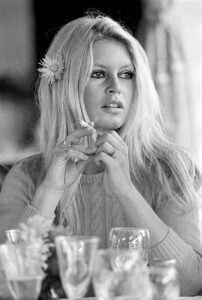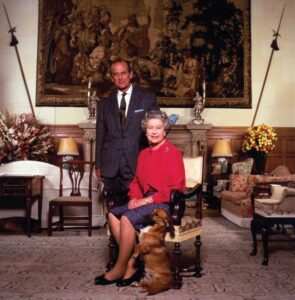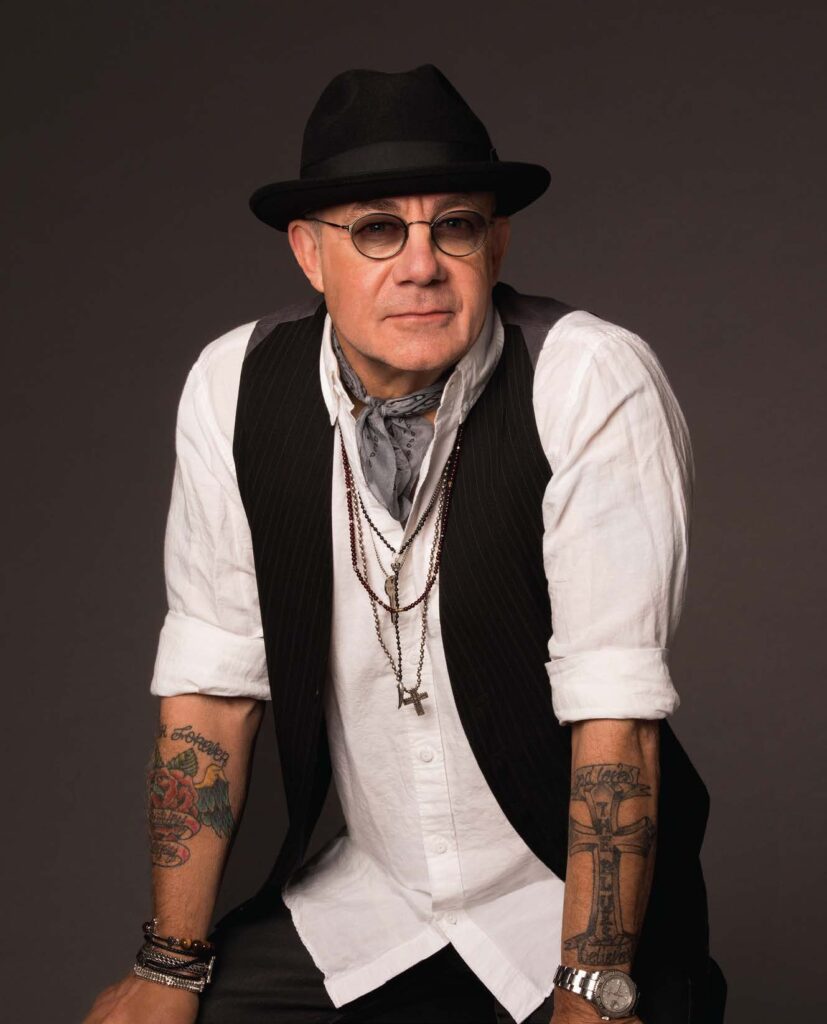“I’ve been called a writer, poet, lyricist, painter, sculptor. I prefer: ‘Artist’.” – Bernie Taupin, 2018
Two Sides of the Sixties
“Terry O’Neill was both a great friend and an inspiration. His personality behind the camera was an infectious and kinetic pantomime of chaotic charm.
Terry was a star in his own firmament as much as the icons he photographed over the decades. His images are indelible classics. Even if you don’t know who took them, many are as familiar as old friends.
He chronicled the coolest of the cool and captured them in all their legendary magnificence. His subjects are so alive, so aware and so relaxed that I can only imagine Terry’s good humor and energy made for their unique collaborative chemistry.
That he trusted me and allowed me to cherry pick his portfolio speaks volumes of his sense of adventure. I’m beyond grateful that this project was conceived and completed in his lifetime and that it was a collaboration he fully endorsed and embraced.
I will always miss him, but when I think of him, it’s his spirited direction and laughter that still ricochets around my head.” – Bernie Taupin
Bernard John Taupin, b 1950. Sleaford, United Kingdom
Bernie Taupin is a life-long artist. In the early 1990’s painting became the main thrust of his creative endeavors. In his early work Taupin was inspired by ground-breaking abstract expressionists including Franz Kline, Mark Rothko and Hans Hoffmann, and Anselm Kiefer in scale and materials.
Taupin says, “As in any creative field, we start by emulating work we like, following the path that ultimately leads to finding our own vision, a style we feel is original and unique in its own beliefs, on its own merits.”
Taupin artwork evolved from Ab-Ex explorations to a level of self-satisfaction followed by experimentations with text-based content and minimalist pop-art concepts. By 2016 and 2017 works become sculptural constructions off and through the canvas and bound with cord and wire. Expressing with found objects and re-purposed material and artifacts, Taupin’s multi-layered creations include manipulated flags, scorched canvas, wax, wire, wood, cardboard, fabric, resin.
“The imagination is the most powerful tool artists possess enabling us to conjure up beautiful distraction for the eyes and ears. My dimensional work is simply the visual extension of what I have spent my life creating through words.”
1950
Born in very rural northern England on a farm in a house with no electricity. Taupin’s earliest education came from his mother reading him English classics including the narrative poetry of Alfred Lord Tennyson and Lord Byron and exploring picture books of the paintings of JMW Turner. Bernie’s father, a multi-decorated World War II veteran, became a cattle hand after the war.
1958
Growing up in post WW-II Europe, with appreciation that America lead the way to victory, Bernie’s earliest imaginations aligned himself with the dreams of America. Fascinated by the history of America and the American West, 8-year old Bernie begins to write and dreams of becoming a true American cowboy.
Taupin Timeline:
- 1967 The 17-year old Taupin answered an advertisement for new song-writers placed by London’s Liberty Records. Meets, begins work with Reginald Dwight.
- 1968 Writes “Your Song”.
- 1969 Completes lyrics for album, “Empty Sky”.
- 1970 Completes lyrics for albums “Elton John” and “Tumbleweed Connection”.
- 1970 Shares the limelight at the Troubadour, Los Angeles with future rock-star, Elton John. 1970. Visits Museum of Modern Art, New York, experiences Abstract Expressionism.
- 1970 – Present Writes lyrics for over 700 songs including Tiny Dancer, Bennie and the Jets, Candle in the Wind, Crocodile Rock, Rocket Man, Daniel, I’m Still Standing and more …
- 1971 Releases spoken word album of poetry, “TAUPIN”.
- 1985 Buys a ranch in California; becomes a real ‘brown dirt cowboy’, training and competing non-pro cutting horse circuit.
- 1988 Writes autobiography, A Cradle of Haloes: Sketches of a Childhood.
- 1990 Becomes US citizen.
- 1991 Writes/publishes a book of poems, The Devil at High Noon.
- 1992 Receives Johnny Mercer Award. Inducted into Songwriters Hall of Fame.
- 1995 Converts music studio at the ranch into large art studio.
- 1996 Forms band, Farm Dogs, two albums, Immigrant Sons and Last Stand in Open Country.
- 2003 First art exhibition, Los Angeles.
- 2010 – 2014 Hosts weekly American Roots Radio show from the ranch studio on Sirius XM.
- 2010 – 2023 Art Exhibitions: Aspen. Atlanta. Austin. Beverly Hills. Bridgehampton. Chicago. Dallas. Denver. Edmonton. Houston. Los Angeles. Miami. Nashville. New York. Palm Springs. San Diego. San Francisco. Toronto. Vancouver.
- 2016 Honored with an exhibition, Cultural Council Palm Beach.
- 2020 Oscar with Elton John. Best Original Song 92nd Academy Awards, ROCKETMAN movie.
- 2021 Exhibits 60 works spanning 20-years, “American Anthem” Museum of Biblical Art, Dallas.
- 2022 Receives Commander of the British Empire for his Contribution to Music.
- 2023 London premier artwork exhibition, collaboration w Terry O’Neill (created 2015).
- 2023 Hatchette Books releases Bernie Taupin “Scattershot: Life, Music, Elton and Me.”
- 2023 New York Times Best Selling author.
- 2023 Inductee, Rock and Roll Hall of Fame.
- 2024 Two Sides of the Sixties, exhibition, Palm Beach.
- 2024 Along with song writing partner, Elton John, receives Gershwin Award.
Oh What A Night, Sophia Loren, 1978

Italian actress Sophia Loren cuts a wistful figure during the filming of the 1978 film Brass Target in Switzerland. The frame on the wall, which in the original photograph held a painting of a medieval court scene, is replaced in Taupin’s interpretation by a colorful abstract-expressionist piece, its paint leaking into the containing photograph to form a unsightly orange blotch on the actress’s pristine white sheets.
- Archival Pigment Photograph on Hahnemuhle Archival Photo Rag Paper (edition of 50) 44 x 30 inches

Hippy Hat, Audrey Hepburn, 1966

Film and fashion icon Audrey Hepburn dons Oliver Goldsmith sunglasses on the set of How to Steal a Million, a comedy directed by William Wyler. Taupin has re-imagined the empty white space of her felt helmet as a psychedelic portal, containing a vibrant ecosystem of cosmic and nature motifs. The original photograph was taken in Paris, France, 1966.
- Original, Mixed Media on Canvas 50 x 32 inches
- Archival Pigment Photograph on Hahnemuhle Archival Photo Rag Paper (edition of 50) 44 x 30 inches

It Came from Hoboken, Frank Sinatra, 1968

Actor and singer Frank Sinatra smokes during the making of The Lady in Cement in Miami, 1968. The title of Taupin’s reworking doubles as a reference to Sinatra’s hometown, and a homage to the 1953 American science fiction horror film It Came from Outer Space.
- Original, Mixed Media on Canvas 33 1/2 x 50 inches
- Archival Pigment Photograph on Hahnemuhle Archival Photo Rag Paper (edition of 50) 31 x 44 inches

Full Control to Col Tom, Elvis Presley, 1969

In his famous high collar and a scarf, legendary singer Elvis Presley arrives at the International Hotel in Las Vegas, Nevada on August 1st, 1969, the day of his comeback press conference. With his addition of a wall of multi-colored, pixel-like blocks, Taupin’s reworking and its title allude to the coercive influence Elvis’s manager Colonel Tom Parker held over the singer’s life and career.
- Original, Mixed Media on Canvas 50 x 34 inches
- Archival Pigment Photograph on Hahnemuhle Archival Photo Rag Paper (edition of 50) 44 x 31 inches

Her Heinzness, Royal Highness Queen Elizabeth II, 1992

Terry O’Neilll’s 1992 official portrait of Her Royal Highness Queen Elizabeth II, her visage bordered by Taupin’s repeating pattern of the Heinz baked beans logo. Though it originated in the US, the iconic food is to the British national consciousness what Campbell’s tomato soup, which featured in paintings by Andy Warhol, is to America’s.
- Archival Pigment Photograph on Hahnemuhle Archival Photo Rag Paper (edition of 50) 34 x 34 inches

When I Grow Up, John Lennon, 1964

Lennon belts out a note during the rehearsal for a TV special at Wembley Studios in April, 1964. Looking especially boyish in his glasses and sweater vest, Lennon’s image is paired with notes, written from his younger self’s perspective, which express his dream of becoming a famous musician when he grows up. The piece is particularly poignant when considering how famous Lennon went on to become, and how it later led to his murder.
- Archival Pigment Photograph on Hahnemuhle Archival Photo Rag Paper (edition of 50) 40 1/2 x 34 inches

Floral Goddess, Brigitte Bardot, 1968

Brigitte Bardot enjoys a casual lunch before setting off to promote her latest film, Edward Dmytryk’s 1968 British-German-American Western Shalako, which co-starred Sean Connery. Taupin replaced the flower in her hair in the original photograph with colorful fabric flowers and more standing like cocktail garnishes on the rims of the glasses at the bottom of the shot.
- Original, Mixed Media on Canvas 50 x 33 1/2 inches
- Archival Pigment Photograph on Hahnemuhle Archival Photo Rag Paper (edition of 50) 44 x 31 inches

Sex Bomb, Raquel Welch, 1970

Raquel Welch rides a replica of a bomb on the set of Myra Beckenridge, a comedy based on Gore Vidal’s novel of the same name and directed by Michael Sarne in 1970. Four years earlier, the actress had become an international sex symbol when the image of her in a doe-skin bikini on the set of the film One Million Years B.C. became a bestselling poster globally. She had only three lines in the film.
- Original, Mixed Media on Canvas 50 x 34 inches
- Archival Pigment Photograph on Hahnemuhle Archival Photo Rag Paper (edition of 50) 44 x 31 inches

Made in the USA, Paul Newman, 1972

Paul Newman poses in a cowboy hat in Tucson, Arizona, 1962, in a publicity still for the 1972 comedy western Pocket Money. Newman – behind whom Taupin has arranged a downpour of Double Bubble Bingo slot machine fruits and a section of the stars and stripes – was a conflicted patriot: a lover of cars and cold Budweiser who found himself on Richard Nixon’s enemies list for opposing the Vietnam War.
- Original, Mixed Media on Canvas 50 x 33 1/2 inches
- Archival Pigment Photograph on Hahnemuhle Archival Photo Rag Paper (edition of 50) 44 x 31 inches

Wot a Diamond Geezer, Michael Caine, 1970

Michael Caine grips a rifle on the set of the 1970 film Get Carter. Both Taupin’s title and his vivid card-suit-diamond motifs allude to Caine’s status as the quintessential working class Londoner in show-business, or, in cockney parlance, a ‘diamond geezer’.
- Archival Pigment Photograph on Hahnemuhle Archival Photo Rag Paper (edition of 50) 44 x 31 inches

The Constellation Dino, Dean Martin, 1971

American actor, singer and Rat Pack member Dean Martin straightens his tie backstage at a Las Vegas nightclub in 1971. The darkness that surrounds Martin in the original photograph is filled by a galaxy of stars, martini glasses and dancing-girl designs reminiscent of the old-school neon displays that advertised clubs across America, forming a nightlife constellation with Dean Martin at its center.
- Original, Mixed Media on Canvas 50 x 41 inches
- Archival Pigment Photograph on Hahnemuhle Archival Photo Rag Paper (edition of 50) 40 1/2 x 34 inches

Can’t Buy Me Love, Richard Burton and Elizabeth Taylor, 1971

The then-married actors Richard Burton and Elizabeth Taylor in Burton’s trailer during the filming of the 1971 film Villain. The couple, both highly successful film stars, were twice married and twice divorced. According to the Associated Press, Burton bequeathed the bulk of his 2.7 million dollar estate to his fourth wife, Sally Hay Burton. He left Taylor nothing. In Taupin’s rendition, the doomed lovers pose before dollar-sign wallpaper, holding Cupid’s broken wings.
- Archival Pigment Photograph on Hahnemuhle Archival Photo Rag Paper (edition of 50) 44 x 31 inches

Confectionary St., Queen Elizabeth II and Prince Philip, 1992

Queen Elizabeth II and Prince Philip pose for their official portrait in 1992. The piece on the wall in the background, which originally depicted a medieval scene, has been replaced by a vibrantly-colored collage of logos from quintessentially British brands, a comment on the broad scope of national identity.
- Archival Pigment Photograph on Hahnemuhle Archival Photo Rag Paper (edition of 50) 34 x 34 inches

Bond, James Bond, Sean Connery, 1971

A majestic 1971 shot of Sean Connery, the original 007, standing over a hood of an Aston Martin, holds his vivid reflection, backdropped in Taupin’s reworking by a bright Union Jack. The flag’s bold colors contrast with the black-and-white figure of Connery to emphasize the historical and cultural significance of both the actor and the iconic MI6 agent he epitomized.
- Original, Mixed Media on Canvas 50 x 33 1/2 inches
- Archival Pigment Photograph on Hahnemuhle Archival Photo Rag Paper (edition of 50) 44 x 30 inches

The True Identity of Superman, Muhammad Ali, 1972

The world’s greatest ever boxer, Muhammad Ali, trains for his fight with Alvin Lewis in Dublin, 1972. The logo superimposed on his chest, and the comic-book sound effects surrounding the speed-ball he’s striking, are inspired by Ali’s famous retort to an air stewardess when she asked him why he wasn’t strapped in like the other passengers: ‘Superman don’t need no seatbelt!’
- Archival Pigment Photograph on Hahnemuhle Archival Photo Rag Paper (edition of 50) 44 x 30 1/4 inches


